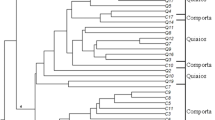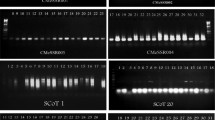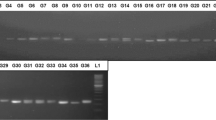Abstract
Chrysanthemum is an important floriculture plant worldwide. This study aims to examine the genetic diversity and similarity levels of 35 garden-type chrysanthemum genotypes of Chrysanthemum morifolium and Chrysanthemum indicum species sampled from different provinces of Türkiye, namely Konya, Kayseri, Aksaray, and Adana, based on morphological, biochemical, and molecular markers. Based on the findings of the present study, a wide variation was found in chrysanthemums in terms of morphological features. The findings further indicated that chrysanthemums were highly variable in terms of plant growth pattern, leaf, and branching characteristics, flower shape, flower color, and flowering times. The total phenolic contents of different garden chrysanthemum genotypes belonging to different species and genotypes varied between 1 and 5.68 mg GAE/g. Chrysanthemum genotypes showed strong antiradical activity against DPPH radical with the values between 22 and 86%. Morphological and biochemical features were supported by molecular data. The dimensions of genetic diversity were determined with 11 inter-primer binding site (iPBS) markers, and the similarity indexes of the genotypes were between 0.36 and 0.76. The expected and observed allelic frequency values (p, q) depending on the iPBS primers ranged from 0.222 to 0.562 and from 0.438 to 0.778, respectively. In the two and three-dimensional graphics of the principal component analysis prepared in line with the genetic parameters, it was found that the genotypes were clustered based on species and their direct proportion to the morphological characteristics. In this study, garden-type chrysanthemum genotypes sampled from different provinces of Türkiye were characterized. Although this study was conducted in a limited area, remarkably, there is a high variation in terms of morphological, biochemical, and genetic characteristics. This study will guide the transfer of some observed agronomic characteristics to cultivars with breeding programs.





Similar content being viewed by others
References
Anderson NO (2006) Chrysanthemum: dendranthema x grandiflora Tzvelv. In: Flower breeding and genetics: issues, challenges and opportunities for the 21st century, pp 389–437
Baliyan D, Sirohi A, Kumar M, Kumar V, Malik S, Sharma S, Sharma S (2014) Comparative genetic diversity analysis in chrysanthemum: a pilot study based on morpho-agronomic traits and ISSR markers. Sci Hortic 167:164–168
Bonchev GN, Vassilevska-Ivanova R (2020) Fingerprinting the genetic variation and intergeneric hybrid dynamics in the family Asteraceae (genera Helianthus, Echinaceae, Tagetes and Verbesina) using iPBS markers. Biol 75:457–464
Brand-Williams W, Cuvelier ME, Berset CLWT (1995) Use of a free radical method to evaluate antioxidant activity. LWT- Food Sci Technol 28:25–30
Chae SC (2016) An up-to-date review of phytochemicals and biological activities in Chrysanthemum spp. Biosci Biotechnol Res Asia 13(2):615–623
Chong X, Su J, Wang F, Wang H, Song A, Guan Z, Zhang F (2019) Identification of favorable SNP alleles and candidate genes responsible for inflorescence-related traits via GWAS in chrysanthemum. Plant Mol Biol 99:407–420
De LC, Bhattacharjee SK (2011) Ornamental crop breeding. Aavishkar Publishers, New York
Dice LR (1945) Measures of the amount of ecologic association between species. Ecol 26:297–302
Doyle JJ, Doyle JL (1987) A rapid DNA isolation procedure for small quantities of fresh leaf tissue. Phytochem Bull 19:11–15
Duh PD, Tu YY, Yen GC (1999) Antioxidant activity of water extract of Harng Jyur (Chrysanthemum morifolium Ramat). LWT Food Sci Technol 32(5):269–277
Dyer AL, Craig MR, Babiarz JE, Kiyak K, Reynolds JR (2010) Orange and red to transmissive electrochromic polymers based on electron-rich dioxythiophenes. Macromolecules 43(10):4460–4467
Falleh H, Jemaa MB, Neves MA, Isoda H, Nakajima M, Ksouri R (2021) Formulation, physicochemical characterization, and anti-E. coli activity of food-grade nanoemulsions incorporating clove, cinnamon, and lavender essential oils. Food Chem 359:129963
Güneş A, Kordali Ş, Turan M, Bozhüyük AU (2019) Determination of antioxidant enzyme activity and phenolic contents of some species of the Asteraceae family from medicanal plants. Ind Crops Prod 137:208–213
Guo QS, Wang T, Cheng LT, Wen JJ, Wang TY, Liang YN (2008) Study on quality of flavone in various cultivars of Chrysanthemum morifolium for medicine. Chin Med J 33(7):756–779
Hadizadeh H, Samiei L, Shakeri A (2022) Chrysanthemum, an ornamental genus with considerable medicinal value: a comprehensive review. S Afr J Bot 144:23–43
Hammer Ø, Harper DAT, Ryan PD (2001) PAST-palaeontological statistics, ver. 1.89. Palaeontol Electron 4(1):1–9
Huang SC, Tsai CC, Sheu CS (2000) Genetic analysis of Chrysanthemum hybrids based on RAPD molecular markers. Bot Bull Acad Sin 41.
Kalendar R, Schulman AH (2014) Transposon-based tagging: IRAP, REMAP, and iPBS. In: Molecular plant taxonomy: methods and protocols, pp 233–255
Kalendar R, Flavell AJ, Ellis THN, Sjakste T, Moisy C, Schulman AH (2011) Analysis of plant diversity with retrotransposon-based molecular markers. J Hered 106(4):520–530
Kalia R (2015) Effect of different concentrations of auxins on the regeneration of Chrysanthemum morifolium plantlets. Int J Tec Res Appl 3:106–107
Koc S, Isgor BS, Isgor YG, Shomali Moghaddam N, Yildirim O (2015) The potential medicinal value of plants from Asteraceae family with antioxidant defense enzymes as biological targets. Pharm Biol 53(5):746–751
Kumar S, Kumar M, Yadav HK, Sharma S (2017) Genetic diversity and population structure analysis of chrysanthemum (Dendranthema grandiflora Tzvelev) germplasm based on RAPD markers. J Environ Biol 38(3):457
Lemus-Mondaca R, Vega-Gálvez A, Zura-Bravo L, Ah-Hen K (2012) Stevia rebaudiana Bertoni, source of a high-potency natural sweetener: a comprehensive review on the biochemical, nutritional and functional aspects. Food Chem 132(3):1121–1132
Li F, Zhang H, Zhao H, Gao T, Song A, Jiang J, Chen S (2018) Chrysanthemum Cm HSFA 4 gene positively regulate salt stress tolerance in transgenic chrysanthemum. Plant Biotechnol J 16(7):1311–1321
Li Y, Yang P, Luo Y, Gao B, Sun J, Lu W, Yu LL (2019) Chemical compositions of chrysanthemum teas and their anti-inflammatory and antioxidant properties. Food Chem 286:8–16
Lin LZ, Harnly JM (2010) Identification of the phenolic components of chrysanthemum flower (Chrysanthemum morifolium Ramat). Food Chem 120(1):319–326
Luo C, DChen D, Cheng X, Liu H, Yahui LI, Huang C (2018) SSR analysis of genetic relationship and classification in chrysanthemum germplasm collection. Hortic Plant J 4(2):73–82
MacDonald J, Hackett M, Mirmak B (2017) Handbook on chrysanthemum classifcation. National Chrysanthemum Society, USA. https://mums.org/product/classification-handbook/
Martin C, Uberhuaga E, Pérez C (2002) Application of RAPD markers in the characterisation of Chrysanthemum varieties and the assessment of somaclonal variation. Euphytica 127:247–253
Mukherjee AK, Dey A, Acharya L, Palai SK, Panda PC (2013) Studies on genetic diversity in elite varieties of Chrysanthemum using RAPD and ISSR markers. Indian J Biotechnol 12:161–169
Oberprieler C, Vogt R, Watson LE (2006) Tribe anthemideae cass. In: Kadereit JW, Jeffrey C (eds) The families and genera of vascular plants VIII. Flowering plants. Eudicots. Asterales. Springer
Olejnik A, Parkitna K, Kozak B, Florczak S, Matkowski J, Nowosad K (2021) Assessment of the genetic diversity of chrysanthemum cultivars using SSR markers. Agronomy 11:2318
Palai SK, Rout GR (2011) Characterization of new variety of Chrysanthemum by using ISSR markers. Hortic Bras 29:613–617
Samarina LS, Malyarovskaya VI, Reim S, Yakushina LG, Koninskaya NG, Klemeshova KV, Ryndin AV (2021) Transferability of ISSR, SCoT and SSR markers for Chrysanthemum× Morifolium Ramat and genetic relationships among commercial Russian cultivars. Plants 10(7):1302
Shao QS, Guo QS, Deng YM, Guo HP (2010) A comparative analysis of genetic diversity in medicinal Chrysanthemum morifolium based on morphology, ISSR and SRAP markers. Biochem Syst Ecol 38(6):1160–1169
Singleton VL, Rossi JA (1965) Colorimetry of total phenolics with phosphomolybdic-phosphotungstic acid reagents. Am J Enol Vitic 16:144–158
Tang F, Chen S, Deng Y, Chen F (2010) Intergeneric hybridization between Dendranthema crassum and Ajania myriantha. Acta Hortic 855:267–272
Wang Y, Jung JA, Kim WH, Lim KB, Hwang YJ (2021) Morphological and rDNA fluorescence in situ hybridization analyses of Chrysanthemum cultivars from Korea. Hortic Environ Biotechnol 62(6):917–925
Yan W, Jung JA, Lim KB, Cabahug RAM, Hwang YJ (2019) Cytogenetic studies of chrysanthemum: a review. Flower Res J 27(4):242–253
Yang HB, Kang WH, Nahm SH, Kang BC (2015) Methods for developing molecular markers. In current technologies in plant molecular breeding. Springer, Dordrecht, pp 15–50
Zhang F, Chen S, Chen F, Fang W, Li F (2010) A preliminary genetic linkage map of chrysanthemum (Chrysanthemum morifolium) cultivars using RAPD ISSR and AFLP markers. Sci Hortic 125(3):422–428
Žiarovská J, Padilla-González GF, Viehmannová I, Fernández E (2019) Genetic and chemical diversity among yacon [Smallanthus sonchifolius (Poepp. et Endl.) H. Robinson] accessions based on iPBS markers and metabolomic fingerprinting. Plant Physiol Biochem 141:183–192
Author information
Authors and Affiliations
Corresponding author
Ethics declarations
Conflict of interest
The author declares that there is no conflict of interest.
Ethical approval
Ethical approval is not applicable for this article.
Human and animal rights statement
This article does not contain any studies with human or animal subjects.
Informed consent
There are no human subjects in this article and informed consent is not applicable.
Additional information
Publisher's Note
Springer Nature remains neutral with regard to jurisdictional claims in published maps and institutional affiliations.
Rights and permissions
Springer Nature or its licensor (e.g. a society or other partner) holds exclusive rights to this article under a publishing agreement with the author(s) or other rightsholder(s); author self-archiving of the accepted manuscript version of this article is solely governed by the terms of such publishing agreement and applicable law.
About this article
Cite this article
Dalda-Sekerci, A. Comprehensive assessment of genetic diversity in chrysanthemum germplasm using morphological, biochemical and retrotransposon-based molecular markers. Genet Resour Crop Evol 70, 2321–2336 (2023). https://doi.org/10.1007/s10722-023-01634-4
Received:
Accepted:
Published:
Issue Date:
DOI: https://doi.org/10.1007/s10722-023-01634-4




